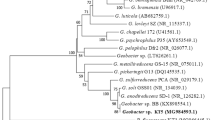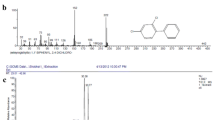Abstract
In this study, a bacterial Bacillus sp. CGMCC no. 4196 was isolated from mud. This strain exhibited the ability to degrade high concentration of 3-chloropropionate (3-CPA, 120 mM) or 3-chlorobutyrate (30 mM), but not chloroacetate or 2-chloropropionate (2-CPA). The growing cells, resting cells, and cell-free extracts from this bacterium had the capability of 3-CPA degradation. The results indicated that the optimum biocatalyst for 3-CPA biodegradation was the resting cells. The 3-CPA biodegradation pathway was further studied through the metabolites and critical enzymes analysis by HPLC, LC-MS, and colorimetric method. The results demonstrated that the metabolites of 3-CPA were 3-hydroxypropionic acid (3-HP) and malonic acid semialdehyde, and the critical enzymes were 3-CPA dehalogenase and 3-HP dehydroxygenase. Thus, the mechanism of the dehalogenase-catalyzed reaction was inferred as hydrolytic dehalogenation which was coenzyme A-independent and oxygen-independent. Finally, the pathway of β-chlorinated aliphatic acid biodegradation could be concluded as follows: the β-chlorinated acid is first hydrolytically dehalogenated to the β-hydroxyl aliphatic acid, and the hydroxyl aliphatic acid is oxidized to β-carbonyl aliphatic acid by β-hydroxy aliphatic acid dehydroxygenase. It is the first report that 3-HP was produced from 3-CPA by β-chlorinated aliphatic acid dehalogenase.






Similar content being viewed by others
References
Ajithkumar PV, Kunhi AAM (2000) Pathways for 3-chloro- and 4-chlorobenzoate degradation in Pseudomonas aeruginosa 3mT. Biodegradation 11:247–261
Armfield SJ, Sallis PJ, Baker PB, Bull AT, Hardman DJ (1995) Dehalogenation of haloalkanes by Rhodococcus erythropolis Y2. Biodegradation 6:237–246
Bergmann JG, Sanik J (1957) Determination of trace amounts of chlorine in naphtha. Anal Chem 29:241–243
Bollag JM, Alexander M (1971) Bacterial dehalogenation of chlorinated aliphatic acids. Soil Biol Biochem 3:91–96
Hardman DJ, Slater JH (1981) Dehalogenase in soil bacteria. J Gen Microbiol 123:117–128
Hayaishi O, Nishizuka Y, Tatibana M, Takashita M, Kuno S (1961) Enzymatic studies on the metabolism of β-alanine. J Biol Chem 236:781–790
Higgins TP, Hope SJ, Effendi AJ, Dawson S, Dancer BN (2005) Biochemical and molecular characterisation of the 2, 3-dichloro-1-propanol dehalogenase and stereospecific haloalkanoic dehalogenases from a versatile Agrobacterium sp. Biodegradation 16:485–492
Janssen DB, Dinkla IJT, Poelarends GJ, Terpstra P (2005) Bacterial degradation of xenobiotic compounds: evolution and distribution of novel enzyme activities. Environ Microbiol 7:1868–1882
Jiang XL, Meng X, Xian M (2009) Biosynthetic pathways for 3-hydroxypropionic acid production. Appl Microbiol Biotechnol 82:995–1003
Jing NH, Wahab RA, Taha AM, Rashid NAA, Huyop AM (2008) A further characterization of 3-chloropropionic acid dehalogenase from Rhodococcus sp. HJ1. Res J Microbiol 3:482–488
Jong RM, Dijkstra BW (2003) Structure and mechanism of bacterial dehalogenases: different ways to cleave a carbon–halogen bond. Curr Opin Struct Biol 13:722–730
Kurihara T, Esaki N (2008) Bacterial hydrolytic dehalogenase and related enzymes: occurrences, reaction mechanisms, and applications. Chem Rec 8:67–74
Kurihara T, Esaki N, Soda K (2000) Bacterial 2-haloacid dehalogenases: structures and reaction mechanisms. J Mol Catal B-Enzym 10:57–65
Mesri S, Wahab RA, Huyop F (2009) Degradation of 3-chloropropionic acid (3CP) by Pseudomonas sp. B6P isolated from a rice paddy field. Ann Microbiol 59:447–451
Staub DK, Kohler HP (1989) Microbial degradation of β-chlorinated four-carbon aliphatic acids. J Bacteriol 171:1428–1434
Tsang JSH, Sam L (1999) Cloning and characterization of a cryptic haloacid dehalogenase from Burkholderia cepacia MBA4. J Bacteriol 181:6003–6009
van Hylckama Vlieg JET, Janssen DB (1992) Bacterial degradation of 3-chloroacrylic acid and the characterization of cis- and trans-specific dehalogenases. Biodegradation 2:139–150
Walker PG (1954) A colorimetric method for the estimation of acetoacetate. Biochem J 58:699–704
Waters P, Venables WA (1986) A complete pathway for β-alanine and β-aminoisobutyrate catabolism in Pseudomonas aeruginosa. FEMS Microbiol Lett 34:279–282
Yamada EW, Jakoby WB (1959) Enzymatic utilization of acetylenic compounds. Acetylene monocarboxylic acid hydrase. J Biol Chem 234:941–945
Yokota T, Fuse H, Omori T, Minoda Y (1986) Microbial dehalogenation of haloalkanes mediated by oxygenase or halidohydrolase. Agric Biol Chem 50:453–460
Yu M, Faan YW, Chung WYK, Tsang JSH (2007) Isolation and characterization of a novel haloacid permease from Burkholderia cepacia MBA4. Appl Environ Microbiol 73:4874–4880
Zhou L, Poh RPC, Marks TS, Chowdhry BZ, Smith ARW (2008) Structure and denaturation of 4-chlorobenzoyl coenzyme A dehalogenase from Arthrobacter sp. strain TM-1. Biodegradation 19:65–75
Acknowledgments
This work was financially supported by the National Natural Science Foundation of China (nos. 20936002 and 21076187), Key Project of Chinese National Programs for Fundamental Research and Development (nos. 2011CB710805 and 2009CB724706), and Hi-Tech Research and Development Program of China (no. 2006AA020103).
Author information
Authors and Affiliations
Corresponding author
Rights and permissions
About this article
Cite this article
Lin, C., Yang, L., Xu, G. et al. Biodegradation and metabolic pathway of β-chlorinated aliphatic acid in Bacillus sp. CGMCC no. 4196. Appl Microbiol Biotechnol 90, 689–696 (2011). https://doi.org/10.1007/s00253-010-3081-6
Received:
Revised:
Accepted:
Published:
Issue Date:
DOI: https://doi.org/10.1007/s00253-010-3081-6




